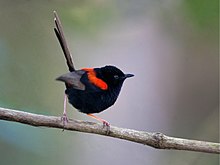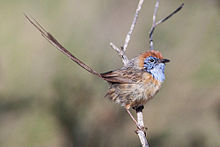Relay tails
| Relay tails | ||||||||||||
|---|---|---|---|---|---|---|---|---|---|---|---|---|

Magnificent easel tail ( Malurus cyaneus ), pair |
||||||||||||
| Systematics | ||||||||||||
|
||||||||||||
| Scientific name | ||||||||||||
| Maluridae | ||||||||||||
| Swainson , 1831 |
The Fairy-Wrens (Maluridae), also Australian singer called, are one in Australia and New Guinea endemic family in the order of the passerines (Passeriformes). With their small size and their often upright tails, they resemble the wrens somewhat , without being closely related to them.
features
Relay tails are small to very small birds with oval bodies that are kept relatively upright when sitting. They are colored in different shades of brown, males of the genus Malurus often show striking blue or red tones . The males of the other genera are also more strongly colored. The wings are short and rounded, the tail is long and is often held upright. The head is medium to large in size, the neck is thick. Legs and feet are delicate, the legs are medium to long, the feet are rather small.
Habitat and way of life
Easier tails occur in different habitats, from bushy semi-deserts to rainforests. They feed mainly on insects, only with the grass hatchlings ( Amytornis ) seeds and fruits can make up a significant part of their diet when insects are scarce. Australian singers breed in small groups made up of a dominant male and several other males and females. Most species build a ball nest, others an open nest. The nests are usually built near the ground. A clutch consists of 2 to 4 eggs. Nest building and hatchery are a matter for the females. After the young birds hatch after 12 to 17 days, the males take part in the feeding of the young. These leave the nest after 10 to 15 days and are fed by the parents for about 10 more days.
Systematics
As with so many Australian species, the Maluridae were often mistakenly incorporated into known families in the past. So they were assigned to the flycatchers , warblers and the timalia . It was not until the end of the 1960s that the close relationship between the three genera was recognized and the family was introduced by Australian scientists in 1975. Advances in DNA analysis at the end of the twentieth century made it possible to further clarify the system: Today the Australian singers are regarded as close relatives of honey-eaters , panther birds and the South Sea warblers . Within the Maluridae two clades can be distinguished, the grass hatchers (genus Amytornis , subfamily Amytorniithinae) and the other genera, which together form the subfamily Malurinae.




Genera and species
The family includes 27 species .
- Subfamily Amytornithinae
-
Grass hatchers ( Amytornis )
- Kalkadoon grass hatchers ( Amytornis ballarae )
- Browgrass hatchers ( Amytornis barbatus )
- Carpentary grass hatchers ( Amytornis dorotheae )
- Eyregrass panties ( Amytornis goyderi )
- Black-throated grass hatchers ( Amytornis housei )
- Short-tailed grass hatchers ( Amytornis merrotsyi )
- Cinnamon grass hatchers ( Amytornis purnelli )
- Striped grass hatchers ( Amytornis striatus )
- Thick-billed grass hatchers ( Amytornis modestus )
- Barley grass hatchers ( Amytornis textilis )
- White-throated grass hatchers ( Amytornis woodwardi )
-
Grass hatchers ( Amytornis )
- Subfamily Malurinae
-
Chenorhamphus
- Broad-billed easeltail ( Chenorhamphus grayi )
-
Clytomyias
- Red-headed easel tail ( Clytomyias insignis )
-
Malurus
- White-shouldered easel tail ( Malurus alboscapulatus )
- Jewelery relay tail ( Malurus amabilis )
- Purple-headed easel tail ( Malurus coronatus )
- Kaiserstaffelschwanz ( Malurus cyanocephalus )
- Magnificent teasel tail ( Malurus cyaneus )
- Silver-headed easel-tail ( Malurus elegans )
- White-bellied easel tail ( Malurus lamberti )
- White-winged easel-tail ( Malurus leucopterus )
- Red-backed easeltail ( Malurus melanocephalus )
- Blue-breasted easel-tail ( Malurus pulcherrimus )
- Turquoise taffeta ( Malurus splendens )
-
Sipodotus
- Rust-naped easel tail ( Sipodotus wallacii )
-
Bristle tails ( Stipiturus )
- Red- forehead bristle tail ( Stipiturus malachurus )
- Mallee bristle tail ( Stipiturus mallee )
- Red-headed bristle tail ( Stipiturus ruficeps )
-
Chenorhamphus
supporting documents
- ↑ a b c d David W. Winkler, Shawn M. Billerman, Irby J. Lovette: Bird Families of the World - An Invitation to the Spectacular Diversity of Birds. Lynx Edicions and the Cornell Lab of Ornithology, 2015, ISBN 978-84-941892-0-3 . Page 325 a. 326.
- ↑ Janet L. Gardner, John WHTrueman, Daniel Ebert, Leo Joseph, and Robert D. Magratha: Phylogeny and evolution of the Meliphagoidea, the largest radiation of Australasian songbirds . In: Molecular Phylogenetics and Evolution . June 2010, doi : 10.1016 / j.ympev.2010.02.005 , PMID 20152917 .